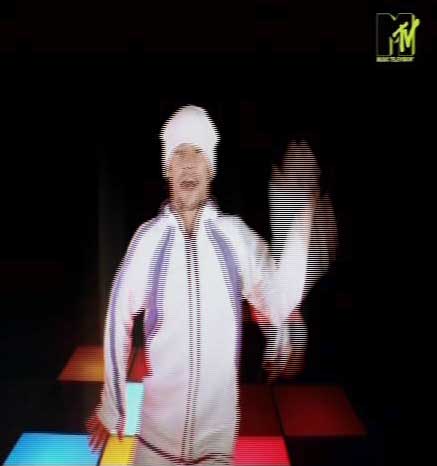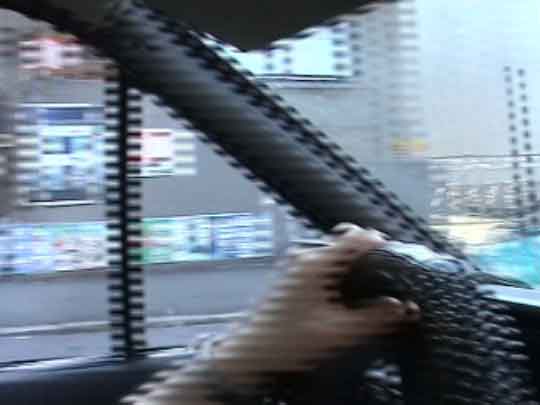|
When is deinterlacing bad?
|
| 1) |
Maybe it sounds stupid, but if you deinterlace a
video which is not interlaced, then the result is worse than the
source of course.
This sounds trivial, but consider the following:
- Some TV channels can air movies in a non-interlaced (=progressive) state while airing the
commercial breaks interlaced.
- TV channels can air a music video clip interlaced and the next one
non-interlaced. The same applies to commercials: One commercial is 25fps, the next one is 50fps.
- TV channels can air the news interlaced, but the intro to the
news (spinning globes etc) is not interlaced.
- The professional coverage of the 11th September attacks by the Saudi Arabian terrorists on the World Trade Center is aired progressively but the amateur footage of the events is aired 50fps.
- Vice versa a coverage may be 50fps, but changes to 25fps when old footage (e.g. World War 2 films with Hitler) is shown.
- A program may be 25fps, but the ending credits are 50fps.
- A program may be 25fps, but a change from one scene to another may be interlaced (see below).
- A single frame can even consist of progressive parts and interlaced parts (see below).
- Some channels air 352x288 which is always non-interlaced (because heights below 300 pixels cannot be interlaced as defined by international committees).
There are some TV channels that air (nearly)
always interlaced (like MTV) and some that switch between
progressive mode/interlaced mode from one program to the other or
within one program without any rule (Futurama
is aired progressive, the following Simpsons is aired interlaced).
Thus this can give you some problems if you deinterlace everything automatically or leave everything progressive. 
Jamiroquai "Little L"
This is a typical capture from the European Channel MTV Central
via digital satellite. As
you can see it's interlaced and has to be deinterlaced. 
The same music clip, the
same scene, but different TV channel (Belgium channel 'Zik). Not interlaced, thus
doesn't need to be deinterlaced. You'd lose quality if you
deinterlaced it, though the quality loss wouldn't be high (see
below),
because the deinterlacing methods described on
this site are quite good. Please also note, that after you
deinterlaced MTV's footage (even with the method 4b) = Hybrid
Method), the result is worse than this
progressive footage from 'Zik.
Side note: The next video music clip after this one, was
interlaced again. Quality
loss after unnecessarily deinterlacing of progressive frames: 
Capture from a commercial for the new Volkswagen
Phaeton.


Magnified original (non-interlaced)

The unnecessarily deinterlaced version. As you
can see only the moving part (the high diver) shows greater
quality loss. Other details are nearly the same.
Another
example from TV: 
The progressive (=non-interlaced) original (Astor
commercial for "Exclamation Mascara" with the 3D
volume formula)

Unnecessarily deinterlaced with the
"Deinterlace - Smooth" filter. Compare the eyelash.
Some of the fine lines have stairs in them. Compare the letters
"ASTOR", they look the same.

Virtualdub's Deinterlacing method
"Duplicate". Compare the fine hairs (top and bottom)
and the letters.

Virtualdub's Deinterlacing method
"Discard" followed by "Bicubic Resize".
Compare the hairs and letters.
Deinterlacing by
blending:

This is Deinterlacing by blending. Not only that a progressive
frame can be motion blurred (look at Jamiroquai's left hand in
the second picture above), now you also blend the next field into this
one. So you really get a blurry result. However, the final
result sometimes is not as bad as you might think. Take this
example of a music clip: It was resized down to 384x284 and thus
hasn't got any interlacing artefacts (mice teeth). It looks
quite good because the original was filmed with 24fps (35mm),
thus had a lot of motion blur in it anyway.

"Rewind" by Cylob (1998). The lady you
see here is the English 15-year-old Chloe Bruce (that's
her real name). She has
won countless (world) championships.  Go
Chloe, kick away bad artifacts
(15 sec, 1.2 MB) Go
Chloe, kick away bad artifacts
(15 sec, 1.2 MB)
Here is an example of non-interlaced
footage. It was shot non-interlaced (=progressive) and it was aired
non-interlaced, thus doesn't need
deinterlacing or other filtering.
It's pretty hires (720x576, thus bigger than
NTSC) so maybe in NTSC countries you haven't something like
that.

This is a commercial for the product "Veet", a leg
hair removal spray (they call it "mousse"), that needs only 8 minutes after application to
remove your leg hair (so they say in this commercial). To make
it even more polishing, here's the  Polish
non-interlaced
version (9.0 MB). No interlacing artefacts, no
deinterlacing artefacts. Pure Polish Progressive Pleasure. Pretty neat.
From the Polish channel Viva Polska. Polish
non-interlaced
version (9.0 MB). No interlacing artefacts, no
deinterlacing artefacts. Pure Polish Progressive Pleasure. Pretty neat.
From the Polish channel Viva Polska. |
| 2) |
 Example 1: Changing from Interlace Mode to Progressive Mode from scene to scene Example 1: Changing from Interlace Mode to Progressive Mode from scene to scene
    
Look at the above commercial for "Garnier Fructis, Color Resist" (click the pictures to zoom).
 The first scene is progressive. You won't see any interlacing mice teeth of the movement of the water drops. The first scene is progressive. You won't see any interlacing mice teeth of the movement of the water drops.
 The second scene is interlaced. You see mice teeth of the movement of the girl. The second scene is interlaced. You see mice teeth of the movement of the girl.
 The third scene is progressive again. You won't see any interlacing lines of the wringing movement. The third scene is progressive again. You won't see any interlacing lines of the wringing movement.
 Example 2: Interlacing on top of a progressive frame Example 2: Interlacing on top of a progressive frame
Strange but true: A frame can consist of
non-interlaced parts and interlaced parts:

Stefan Raab "Wir kiffen"
Look at the logo in the upper right corner. This is a capture
where the logo (of the channel Pro7) just slides in from
the right. The movie itself is not interlaced. You won't find
any mice teeth anywhere.
 Example 3: Interlacing within a progressive frame Example 3: Interlacing within a progressive frame

Look at the above commercial for the product "Ariel". This
is a scene, where the camera zooms in to the TV set, while
there's a movie playing on the TV set's screen. The commercial
is non-interlaced, but the movie within the movie is.
 Example 4: The scene change is interlaced, while the scene is progressive Example 4: The scene change is interlaced, while the scene is progressive

This is a footage from a comedy show featuring a black&white comedy sketch. The comedy scenes were aired progressively all of the time. At the end of the sketch (new comedians slide in from right to left) the sliding itself was aired interlaced.
|
| 3) |
Deinterlacing a movie which has been artificially
interlaced can give worse results than specific methods.
What do I mean by that? As you may know, cinema movies (and all films
filmed with professional cinema equipment or special camcorders,
e.g. most music videos) are filmed with 24 progressive frames
per second. "Progressive" means "Not
interlaced". It means a "A frame is a field". It means
"One
snapshot of a time is taken 24 times per second in a minute, not
50 times" (like with DV camcorders). As you may also know, TV
channels have to air with 25 frames per second (or ca. 30 frames
per second in USA and other countries).
That means, that 24fps (progressive) have to be converted to
25fps (interlaced) or to 30fps (interlaced).
To covert to 25fps
you simply play that movie faster by 4% and as another step you have to convert the progressive frames to
interlaced frames by artificially doubling the frame (repeating)
and combining one field with another field of the
next frame to interlace them.
As a side effect DivX (or any other codec)
has to encode effectively only 25fps (after deinterlacing), though the resulting video
is 50fps. When you scrutinize the frames you will notice
that 2 consecutive frames are almost the same:
     
This is the crash from Cardigans "My favourite game". Here you can see the lead singer coming
from the left and crashing into the other band members coming
from the right (and being catapulted over the car). As you
see frame1=frame2, frame3=frame4, frame5=frame 6. They are not
totally equal but nearly. (Side note: There
are 4 versions of the music clip with different endings).
On the other hand to convert 24fps to 30fps you have to make 5 video frames out
of every 4 film frames. Really crazy stuff. As side effect the movie stutters all the time.
When you see a long slow
camera movement they go sloooow-fast-sloooow-fast.
Unbelievable that this quality destroying mess is
the standard of TV and DVD.
This conversion by the way is called
"Telecine". The most understandable examples would be animated
cartoons. Or did you think they are painted interlaced?

Frame1 (TV capture)

Frame2

Frame3
As you see the interlacing in frame 2 is totally artificial.
Frame1 and Frame3 are the real painted frames. Frame2 is a mix
of frame1 and frame2.
Because this is an artificial step you can undo it without
really deinterlacing it but simply by undoing it, which is called
"Inverse Telecine" (=IVTC) or "Reverse Telecine" (30fps->24fps). So inversed telecine would consist of merging fields back to frames and
deleting artificially inserted frames if there are any. In my example with Crusty the Clown from the series "The
Simpsons" you can simply delete Frame2 as it
wasn't meant to be by the cartoonists anyway.
There are filters for Virtualdub with which you can achieve
that. The problem is whether it's worth the trouble. Of course
you may get slightly better results with real inversed telecine 24fps than with
deinterlaced 50fps. But before that you would have to inspect
whether it's a telecined clip or a real interlaced one. And just
look at the choices: The following are the options for the Inverse
Telecine filter (for Avisynth) by Donald Graft. Well, go
ahead. Even if
you can use all of them you are still left with a big chance of not
getting anywhere because of bad movie sources, so to deinterlace the filter would
just blend or interpolate, which are bad deinterlacing
methods. But nonetheless, Donald Graft has made a few of the
finest filters for Virtualdub in the net (including this
complicated one):
| Oh my god!
There's no GUI (Graphical User Interface) by the
way, so you have to edit all the options in an text
editor.
|
Telecide accepts the following
parameters:
Telecide(Reverse Field Matching, Swap Fields, Blend
First/Last Frames, DeInterlace Non-Matching Frames,
Field Detection Threshold, Field DeInterlace Threshold,
Blend instead of Interpolate, Use Chroma Search, Exclude
Line Start, Exclude Line End)
Recommended Setting (these are also the defaults if no
value is set):
Telecide(reverse=false,swap=false,firstlast=false,post=true,threshold=15,dthreshold=9,blend=true,chroma=false,y0=0,y1=0)
Some of these parameters may not be clear so I will
explain them in detail:
- Reverse: Reverse Field Matching
(true/false, Default "False").
Some badly authored DVD content or sources captured
using a Capture card may have the prominent field
reversed which may cause interlaced output even
though the video was originally progressive. This
setting reverses the matching order and may resolve
these issues.
- Swap: Swap Fields (true/false,
Default "False").
Swapping Fields is the process where every second
line is swapped with the line above it. Some capture
cards capture the fields in the wrong order and
using this setting you can fix the issue.
- FirstLast: Blend First/Last Frames
(true/false, Default "False").
In a lot of cases, the first and last frames of a
video will have a missing field, which would prevent
field matching. If you want to ensure that these
frames are blended, enable this parameter. However,
in most cases due to editing the first/last frames
of a video is usually black and won't require this
setting.
- Post: DeInterlace Non-Matching
Frames (true/false, Default "True").
In certain conditions it may be impossible to
reconstruct a progressive frame (scene changes, bad
editing on the original source material). When this
setting is enabled, it will compensate for this by
either Blending the fields to smooth the artifacts
or by Interpolating the fields to estimate motion
(according to the "blend instead of
interpolate" setting). Before enabling this
setting, it's usually wise to load the clip with it
disabled so you can see if your field order is
correct. Otherwise, you would get a blurry video.
Once you inspected that most of the frames match
properly, re-enable this setting to make sure no
interlaced frames sneak in.
- Threshold: Field Detection
Threshold (0-255, default "15").
This is the value that determines which area is
considered interlaced and which is considered
progressive. The lower the value, the more the image
is considered interlaced.
- dThreshold: Field DeInterlace
Threshold (0-255, default "9").
When combing is detected after the field matching
process, this setting determines the detection
sensitivity of the remaining interlacing that will
later be blended or interpolated.
- Blend: Blend instead of Interpolate
(true/false, default "True").
Blending gives a smoother image with better motion
but with slight ghosting, an interpolated image may
have a sharper image but motion may be jumpy and the
image may be have additional noise. On a whole,
Blending provides a better image quality but is
slightly slower (only when non-progressive frames
are found).
- Chroma: Use Chroma Search
(true/false, Default "false").
By default only the Luma (brightness) of an image is
used to check for interlaced data. However, certain
types of content (Animation mostly) it may also be
wise to look at the Chroma (Color). Unless you're
using Animated content, I recommend leaving this
disabled.
- Y0: Exclude Line Start (0-4095,
Default "0").
In some cases where you may have an on-screen logo,
or perhaps subtitles, this overlayed data (that
isn't part of the original show) may confuse the
field matching code. In order to exclude this area
of the screen from being checked for matching
fields, you use the Y0 and Y1 parameters. The Y0
parameter defines which starting line should be
excluded.
- Y1: Exclude Line End (0-4095,
Default "0").
The Y1 Parameter defines which ending line should be
excluded. Any lines in between Y0 and Y1 are
ignored. If Y0 and Y1 have the same value, the
excluding setting is disabled. Since by default
their values are both "0", the entire
image is checked for field matches.
Note that the field matching Aspect and
adaptive deinterlace function makes Telecide perfect for
Phase Shifted or Field Blended PAL sources as well.
Decimate accepts the following parameters:
Decimate(Cycle in [n] Frames, Decimate Mode, Hybrid
Threshold)
Recommended Setting (these are also the defaults if no
value is set):
Decimate(cycle=5,mode=0,threshold=0)
- Cycle: Cycle 1 in [n] Frames
(2-25).
Basically you tell Decimate to remove one frame
every [n] number of frames. For use with IVTC you
would like to remove 1 duplicate frame from every 5
frame sequence, so the value would be "5".
- Mode: Decimate Mode (0-1).
In mode "0", 1 every [n] frames will be
removed from the video. In mode "1",
instead of removing the frame, the duplicate frame
is blended with the previous frame and thus motion
becomes smoother while remaining at the same frame
rate. This is useful if your source video is a
hybrid of 24fps and 30fps content and you don't want
to make the 30fps content jerky by discarding one of
it's frames. This is the case in quite a few series
that incorporate live-action with computer generated
images (such as Andromeda and Babylon 5).
- Threshold: Hybrid Threshold (0-99).
When using mode "1" to blend duplicate
frames on hybrid 24fps/30fps content, you don't want
blended frames on the 30fps content. To prevent that
from happening, you define a threshold which
determines the difference between frames for decomb
to deduct which frames should be blended. A value of
25-50 should be ok for DVD content. You may want to
experiment to see what works best for you.
|
|
|
|
| 4) |
If you have interlaced material (like DV from your
camcorder) and want to display it on TV sets (with a SVCD for
example) instead of computer screens, then you don't need to
deinterlace. If you wanted to play deinterlaced material, your
TV screen would not be able to display it OR it would have to
interlace it and you will lose quality.
However, there might be cases where you want to deinterlace
anyway:
a) If you have to resize the height then you have to
deinterlace. If you have a PAL DV which is x576 and you want to
save the movie onto a PAL SVCD, which is also x576, you don't
need to deinterlace. But as soon as you resize the height (for
an NTSC SVCD for example) you have to deinterlace. (However you
can save yourself the resizing/deinterlacing by cropping=
cutting off lines.)
b) If you rotate the frame (for effects).
In these cases you have to deinterlace (and probably
interlace again later), otherwise you will get strange effects
like these:

Resizing height without deinterlacing first

Resizing height + rotating without deinterlacing
first
|
| 5) |
You may not want to deinterlace specific frames,
where nothing moves. If nothing moves there aren't any mice
teeth, thus no deinterlacing is needed. Please see the examples
of walls in the table below.

|
|
|
